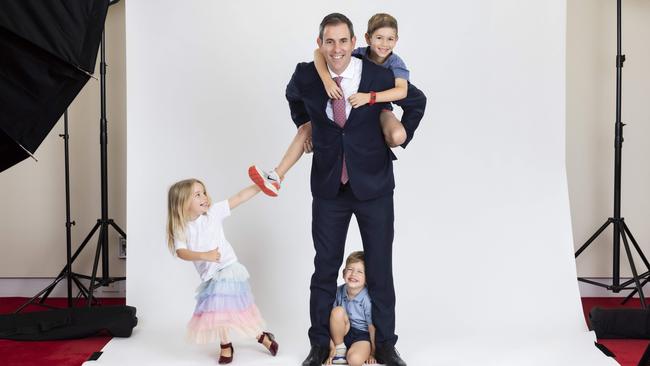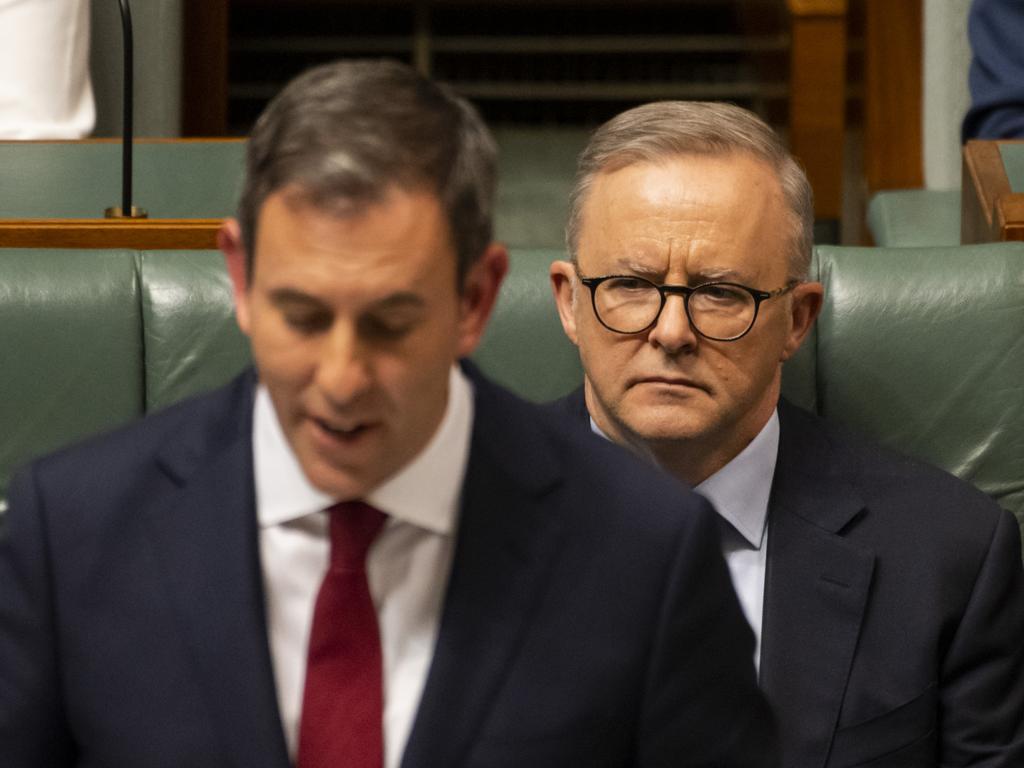Budget 2022: No more playing for time
Labor’s fiscal reset missed the mark and now it must argue for budget repair as Australians are hit with big price hikes for energy.

When this reporter collected the budget papers in the lockup in Parliament House, they seemed scaled back and wan, even with a reprised blue colour scheme; compared with the heft and paraphernalia of the Coalition’s first instalment of the 2022-23 budget at the end of March, this week’s version may have been on the herbal tea diet.
Sure, big isn’t necessarily beautiful, but is this a warm-up or the main event? Slim Jim may have given us the best mid-year update ever, with Treasury essentially bringing forward the work it usually presents in December. At best, the budget is a prelude, a work in progress, a draft for comment. Plainly, it’s a missed opportunity to leave a big impression.
At worst, the budget may foreshadow a loss of courage in battle, a retreat to reconfigure a proper strategy and to fight another day.
Governments love set pieces, and Albanese Labor’s rhythm since winning in May has been a series of these moments: first sitting of the 47th parliament in late July, the Treasurer’s economic statement a few days later, the Jobs and Skills Summit last month and, finally, Tuesday’s budget.
These events are a mix of symbolism and substance, as well as deadline discipline to get things done; too many of these markers, however, if they’re merely pumped-up “announceables”, and ministers lose their way.
Readers with memories going back to, say, early 2008, will know about the retail culture that set in with Kevin Rudd and continued through the baton relay of executive power right up until Scott Morrison’s concession speech.
So far, Anthony Albanese is proving to be a different leader; the Prime Minister doesn’t hog the cameras, while there are a range of able talking heads to set the daily agenda. Until this week’s fiscal policy reveal, there was little political frisson to sour the new tone of adult diligence, as Chalmers claimed at his National Press Club post-budget address.
The budget was basically a political reset: new priorities, new shapes, new narratives. All the moves were well telegraphed as this was a budget pay-up on election promises: on childcare, aged care, training and medicine.
There were measures to fund manufacturing and clean energy, and a new Accord for housing. But there are some promises, or are they aspirations in the wind, such as higher real wages and cheaper electricity
The economic forecasts, too, were conventional for those watching the world go round. Countries producing one-third of the globe’s goods and services were likely to slide into recession, according to the International Monetary Fund. Export prices are falling because of weak demand from China, and beyond but remain near their record highs.
According to Commonwealth Bank senior economist Kristina Clifton, a lower terms of trade, which is a measure of Australia’s import-buying power from the prices we get for exports, “will weigh on company profits and government tax revenue, taking away the easy wins to improve the budget deficit”.
On the cosmetic side, the budget papers included a section, Measuring What Matters, on the trend in rich countries to construct measures of wellbeing and progress. It would be easy to say this is just another stop on Labor’s Great Woke Way, but let’s see where it takes the policy debate on improving our quality of life.
We are a super-rich country, no question, but many people feel like they can’t get a ticket to the show, especially younger workers, or that things were better back in the day. Show us the data.
That’s the branding part of the show: Labor is back.
In fiscal terms, however, the budget was essentially the shock of the old. The dial has barely moved on budget repair. This is risky for a country that faces economic downturns every 10 years or so. We need fiscal buffers so governments can respond to crises and shocks, as they did during the global financial crisis and Covid-19 pandemic.
Canberra’s budget has chronic structural issues, with a medium-term deficit setting of around $50bn in today’s dollars. The Coalition’s strategy to manage the ensuing rise in debt was to grow the economy at a fast clip and take advantage of ultra-low interest rates.
Treasury research about reductions in commonwealth debt in seven previous episodes of consolidation (from the 1920s until the Howard-Costello era) shows how budget surpluses have played a key role in debt reductions, with favourable growth and interest rate dynamics assisting the cause or being neutral.
In a June speech, Treasury secretary Steven Kennedy warned the “current projected reduction in debt to GDP is unusual in that it is relying solely on favourable growth and interest rate dynamics to reduce the ratio”.
“A more prudent course would be for the budget to assist more over time,” he said. “This would especially be the case if growth and interest rate dynamics become less favourable over time.”
Well, guess what the US Federal Reserve, and every other consequential central bank, has been up to the past few months? The era of cheap money is over.
Next year, our GDP growth rate is likely to be cut in half, to around 1.5 per cent, and unemployment is set to rise to 4.5 per cent by mid-2024 as the Reserve Bank of Australia’s “whatever it takes” monetary policy bites.
We’ve known for a while the National Disability Insurance Scheme is getting away from us. The cost of this national treasure, a necessary enabler and life-transforming scheme, is growing by 13.8 per cent a year and is expected to cost $50bn a year by the end of the current budget period in 2025-26. Debt interest costs are taking up a greater chunk of the federal budget. Insane energy price rises, arguably our economy’s greatest enemy, during the next two years will smash household purchasing power and business finances.
The costs of an ageing society, in health and aged care, and higher inflation (which raises the welfare bill because of indexation of payments) are going to keep federal spending at a lofty 27 per cent of gross domestic product across the forward estimates, before rising over the decade.
At one-quarter of GDP, the tax take is inadequate to fund Big Canberra; the system is leaky and in many aspects inefficient, unfair and prone to aberrations. Chalmers has been dogged in ruling changes out on tax, such as tinkering with the GST or a super-profits tax on energy companies.
He says Labor will crack down on business tax loopholes and make sure multinationals “pay their fair share”. The measures in the budget on that front were minimalist, yielding less than $5bn across four years.
Chalmers claims his first effort “begins the hard yards of budget repair” with “hard decisions for hard times”.
“While our economic policies put a premium on resilience, our fiscal strategy puts a premium on restraint,” he said in his budget speech.
What is that strategy? Basically, it’s vanilla and vanilla, in a recyclable cup: returning revenue upgrades to the budget and keeping a lid on spending growth. As yet, there are no hard spending rules or tax caps.
At the National Press Club on Wednesday, Chalmers trumpeted Labor’s prudence: virtually all of the revenue windfall from high commodity prices and a stronger economy improves the bottom line. He said this was the “biggest ever instance of returning tax upgrades to the budget” – $124bn, excluding GST, and $114bn returned to the budget, or 92 per cent.
Sorting out spending and taxing is, presumably, on pause until Chalmers’ second effort in May. The Treasurer maintains that in the next few budgets we’ll see a combination of spending trims and tax tweaks,maybe even reform.
Some in Labor’s caucus don’t appreciate the fiscal constraint. All they see is a rabble of a Liberal Party, an outlaw National Party, and new friends on the crossbench they want to become old friends, and a budget that will come good through talk therapy.
“I think the days of pretending that we don’t have structural pressures on the budget are over,” Chalmers said in a response to a question at the NPC by this paper’s Patrick Commins.
“The nation does need to contemplate how we trim spending, how we show budget restraint, and whether we’ve got the best tax system that we can have fit for purpose for the challenges that we confront.”
Contemplate? The news is in. Just do it.







Jim Chalmers knows every part of the “build” in the immense exercise of budget delivery and its intricate after-sales service. Yet the Treasurer’s familiarity with these rituals may have given him too much comfort in the multi-tasking of a fiscal debut, as his unforced error on reducing power bills by $275 showed.